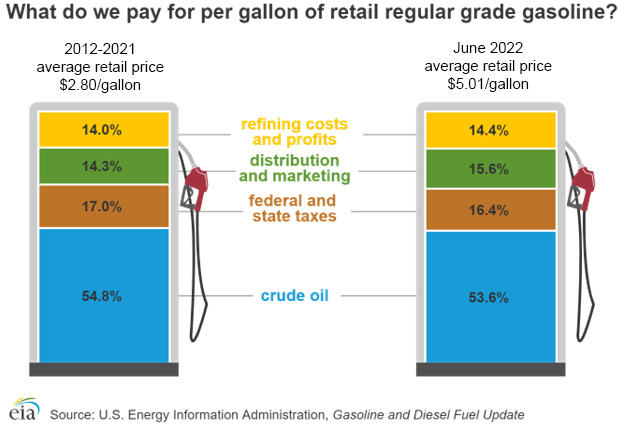Back in May, we wrote about the record low diesel inventories and record high prices due to a reduced number of refineries, backwardation, and an increase in worldwide demand for fuel. And here we are one month later. Has anything changed?
In mid-May, the price of a regular gallon of gasoline was averaging $4.33 across the United States. Now in mid-June, that same gallon of regular gasoline is going for over $5. According to the EIA, that is over $3 more per gallon than just one year ago. In more than 20 states, gasoline is over $5 per gallon, and experts are saying the average family is spending an extra $150 per month on fuel costs alone.

Diesel fuel is also still rising. In March 2020, diesel was averaging $2.493 per gallon. Today, the average for a gallon of diesel has hit over $5.75 in the United States, and in many places across the East Coast, those in need of diesel are paying over $6 per gallon.
For those businesses that use millions of gallons of diesel a year, their costs are rising exponentially. If a business was using two million gallons of diesel a year, they would have paid $4.9 million for their yearly fuel budget in 2020, but in 2022, that’s risen to over $11.5 million. Those in the trucking industry with fewer than 20 trucks in their fleet—which is about 97% of the nation’s trucking companies—are at the point where it doesn’t make sense for them to run their trucks anymore because of the prices.

But one month later, why are prices still so high?
Supply and Demand
Refineries are still operating at reduced pandemic levels. In the last few years, the United States has lost between 1 and 1.5 million barrels per day (bpd) of refining capacity. Europe has lost about 2 million bpd in the last few years. In places like the Middle East, Africa, and Asia, refinery capacity has been growing, but supply chain issues have resulted in delays of delivery of crude oil.
Compounding the issue with supply is the continued increase in demand. As the summer travel season picks up here in the U.S., domestic demand is increasing. International demand has also increased as the U.S. continues to support Latin America and Europe – raising fuel exports.
Export Numbers Rising
In March, April, and May of this year, exports of gasoline, diesel, and jet fuel from the Gulf Coast was up 32% from the same time period last year. So far in June, shipments of these products from the Gulf Coast are expected to be the highest since 2016.
Strain on U.S. Inventories
While the number of exported barrels of crude are rising, the inventories in the United States are shrinking. Gasoline inventories in the U.S. are 11% lower than the five-year average, and diesel inventories are 23% below the five-year average.
As exports continue to rise and inventories are low, the White House is currently considering a restriction on U.S. oil exports, but experts say restricting the exports could backfire and actually raise prices for not just Americans, but the rest of the world, because of the lack of crude oil on the global market.
Summer Blend Gasoline
Another reason fuel prices have increased since May is due to seasonal gasoline transition. In the warmer summer months, gasoline has a greater chance of evaporating, which can produce additional smog and increased emissions. To reduce the chance of gasoline evaporating in your car, refineries produce blends that have a lower Reid Vapor Pressure (RVP), or a lower volatility. It costs the refineries more per gallon to make the summer blend gasoline, raising the price of gasoline from May 1 through September 15, when the EPA requires the lower volatility fuel.
Price of Crude Oil
In the United States, over 53% of the price per gallon of gasoline is determined by the price of crude oil. The rest is made up of taxes, distribution, marketing, and refining costs.
Crude oil is traded on the global market. Prices are set by worldwide supply and demand, influenced by Wall Street commodity traders’ perceptions about future supply and demand.
In an effort to help alleviate prices, the White House is currently considering a restriction on U.S. oil exports, but experts say restricting exports could backfire and actually raise prices for not just Americans, but the rest of the world, because of the lack of crude oil on the global market.

What’s Next?
As we take a look back over the last several weeks, a number of factors remain front and center – low supply, increasing demand, and high prices at the pump. And while we can’t predict the future, our team of energy experts continue to monitor the factors that affect the energy market on a daily basis to help you make the most informed decisions about your energy costs.
From electricity and natural gas, heating oil and propane, gasoline, and diesel, to sustainable green options, we have the flexibility to support all your energy needs, all in one place. Have you talked to an Energy Advisor lately? We’re here to help.


